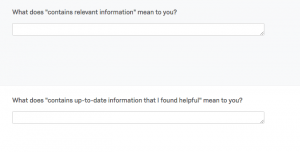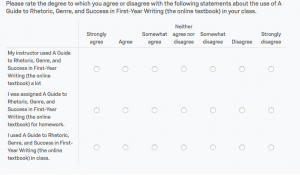10.5 Conducting Your Own Primary Research
Melanie Gagich
Up until this point, Chapter 10 has described the differences between types of sources and helped you to learn how to read academic sources. However, to conclude the chapter, this section provides you with information about how academic research is conducted by academics in the social sciences. It is possible that at some point in your college career, you will be asked to conduct research yourself, and in that case, this chapter will be very useful. Yet, even if you are not asked to conduct your own research, this chapter provides helpful information to aid you in understanding the primary research created by academics in the social sciences.
Specifically, this section provides you with information pertaining to research questions, research methods, research instruments, and research article methodology sections in the hopes that it will help you read academic research and eventually conduct and/or propose your own study.
A key fact to keep in mind: methodological choices must align with the research question(s), which informs the type of instruments used.
Research Questions
Research questions guide an academic study. These questions should not be easily answered. For example, the question “How many people live in the US” is not an appropriate research question because it is easily answered (i.e., you can Google to find the answer) and it does not add new knowledge to a field or discipline.
While you might sometimes be asked to write a research question in college writing, these are often questions that will lead you to arguments and evidence that already exist. In the “real world” of academia, a research question represents a researcher’s attempt to create new knowledge in the field.
Research Methods
The word “research methods” broadly refers to how you plan to conduct your study. There are three types of research methods: qualitative, quantitative, and mixed. Your choice of research methods depends on your research question and the type of data you need to collect to answer that question.
Qualitative Methods
Some research questions focus on opinions, individual experiences, motivations, etc. and generate non-numerical data. These types of questions require qualitative methods to answer them.
Qualitative methods are often used if:
- You want to study a phenomenon/occurrence in detail
- Example research question: How does a freshman ENG 102 student describe their writing process?
- You want to focus on individual interpretations/experiences
- Example research question: What are the experiences of 18- to 25-year-old women using Fitbits for dieting?
To gather qualitative data, researchers often use research interviews, open-ended survey questions, or focus groups.

Quantitative Methods
Other research questions focus on quantifying a problem and generate numerical data. These types of research questions require quantitative methods to answer them.
Quantitative methods are often used if:
- You want to understand the relationship among variables.
- Example research question: What is the relationship between gender and 4.0 GPAs among freshman students?
- You want to understand differences among variables.
- Example research question: What is the difference between attitudes in male and female students in a freshman-level writing course?
To gather quantitative data, researchers often use surveys that include closed-ended questions and Likert-Scale items.


Mixed Methods
Sometimes you need to use both quantitative and qualitative methods to answer a research question. This is known as mixed methods and produces numerical and non-numerical data, which can be collected using a variety of research instruments (including those described above).
The Methodology Section in an Academic Research Article
In an empirical research article, there will be a section outlining the methodology for the study that was conducted. Empirical research refers to knowledge that is gained “by means of direct and indirect observation or experience” (Wikipedia). Including a methodology section in an academic research paper provides the audience with important information such as the participants and the setting of the study as well as descriptions of data collection and analysis.

